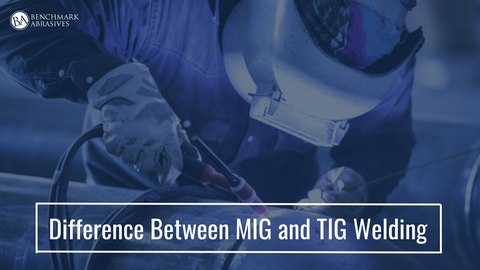
Difference Between MIG and TIG Welding

MIG and TIG are two of the most common arc welding methods, but they differ significantly in their process, speed, cost, and the skill required. Choosing the right one depends on the specific project's needs for speed, aesthetics, and material.
What is MIG Welding?
Also known as Gas Metal Arc Welding (GMAW), MIG welding is a semi-automatic process where a continuous wire electrode forms the arc and provides filler material, while a shielding gas (like an argon and CO2 blend) protects the weld from contamination.
- Speed: MIG welding is significantly faster than TIG, making it the preferred choice for high-production environments.
- Ease of Use: It is often called the "hot glue gun" of welding because it's easier for beginners to learn and requires only one hand to operate the gun and trigger the wire feed.
- Applications: It excels at welding thicker materials like steel, stainless steel, and aluminum, and is widely used in automotive manufacturing, construction, and general fabrication where speed is a priority.
What is TIG Welding?
TIG welding (or Gas Tungsten Arc Welding) is a manual process that creates a welding arc with a non-consumable tungsten electrode. A pure inert gas, usually argon, protects the weld.
- Precision: TIG welding offers a high level of control, allowing for very clean, precise, and aesthetically pleasing welds with minimal spatter. This precision makes TIG welds generally stronger and more consistent.
- Skill: It requires a high level of skill to coordinate both hands and, often, a foot pedal to control the amperage.
- Applications: It is good for welding thinner materials and metals like titanium and chromoly. TIG is ideal for aerospace, custom fabrication, and any project where a flawless, visible weld is a priority.
Differences Between MIG and TIG Welding
#1 Diversity
Being a MIG welder is a better career choice for various reasons. It's more diverse. While TIG welding can be utilized in a broader variety of metals, its use in thicker work is constrained. Aluminum, stainless steel, and steel can all be joined using MIG welding, as can materials ranging in thickness from 26-gauge sheet metal to large structural plates.
This significant benefit of MIG welding over TIG results from the wire feed's dual functionality as an electrode and a filler. Thicker parts can be fused without being heated all the way through. Additionally, MIG welding can be used to join different materials because it employs filler rather than fusing.
#2 Speed
Speed is another argument in favor of MIG vs. TIG. Since a MIG cannon is built to operate continuously for extended periods, it is more effective and productive than a comparable weapon. MIG is the preferred option for primary industrial operations that demand high production rates. (It is also well suited for automation.) On the other hand, TIG welding is a much slower procedure that is detail-oriented.
#3 Cost
Time is money, just as in any production position. The MIG welding technique is also more economical because it is so much faster. MIG parts are also more accessible and far less expensive than TIG ones. TIG welding costs more per foot of bead because the deposition rate is lower. Due to the slightly more expensive consumables, the installation costs are also slightly higher than with MIG.
#4 Ease
And finally, MIG welding is simpler to understand and can be mastered after only a few weeks of instruction. It's been compared to the "hot glue gun" of welding because all you have to do is pull the trigger to initiate or terminate the weld. MIG welders can hold the gun and control it with one hand, making them a better choice for novice welders. On the other hand, TIG welding is a specialist technology that calls for the independent use of both hands and one foot.
MIG vs TIG Welding: Key Differences
| Feature | MIG Welding | TIG Welding |
| Electrode | Consumable wire that doubles as filler. | Non-consumable tungsten. |
| Filler Material | Automatically fed through the gun. | Manually fed with a separate hand. |
| Speed | Fast, high deposition rate. | Slow, precise, and methodical. |
| Ease of Use | Easier to learn for beginners. | Difficult to master; requires high skill. |
| Cost | Generally, less expensive (in terms of equipment and consumables). | More expensive due to slower process and higher-priced consumables. |
| Weld Appearance | Good, but often has spatter and requires cleanup. | Exceptionally clean, strong, and visually appealing. |
| Ideal For | Thick materials, high-production jobs. | Thin materials, precision work, and exotic metals. |
Conclusion
Both TIG and MIG are equally effective. In some circumstances, one may be the better choice, depending on the factors you consider. MIG welding provides faster and less expensive welding on steel and aluminum. Although stainless steel can also be welded, MIG welders are not commonly used. MIG welding is an attractive option for low cost and high production.
TIG welders produce precise, thin, and attractive beads with high penetration powers. However, they are more expensive and require a skilled welder. On the other hand, the TIG method is often preferred for pipe joints, thin stock, and aluminum and stainless steel work where the bead is exposed. Steel can also be TIG welded. But when the steel requires a coating, MIG is often a better choice.



































































